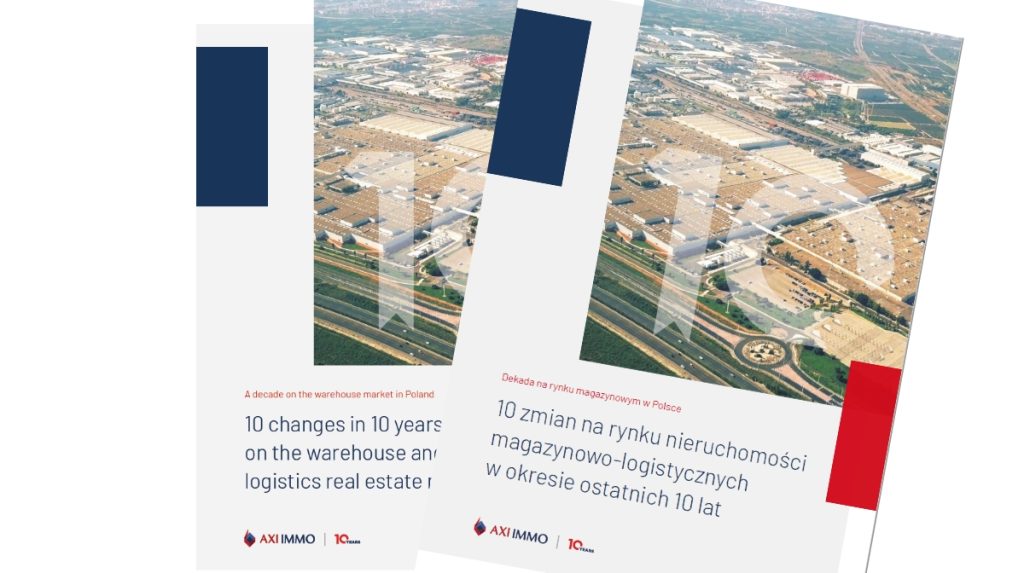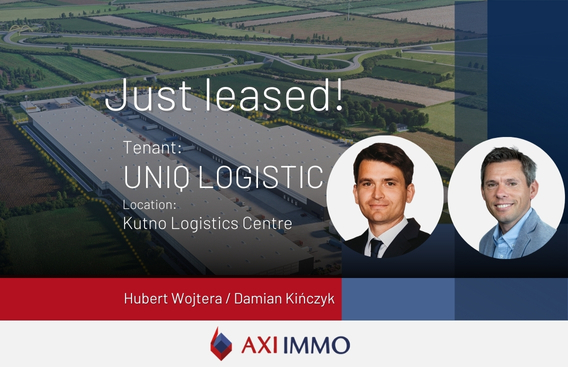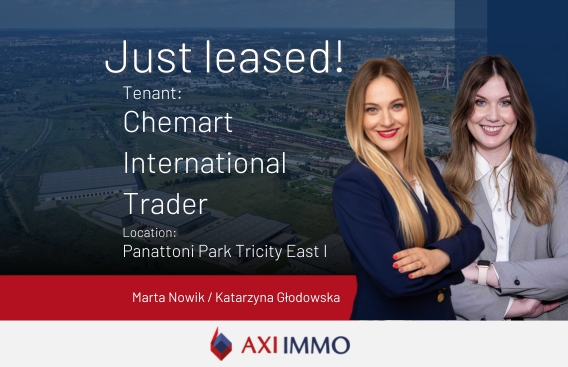Raport: Warehouse market in Poland 2008 – 2018 – 10 changes over 10 years
The warehouse market in Poland in the years 2008 - 2018 has undergone a significant metamorphosis. AXI IMMO experts have distinguished 10 elements that have changed over the last 10 years.

The warehouse market in Poland in the years 2008 – 2018 has undergone a significant metamorphosis. From the growing sector to mature with a stable prospect of growth in the following years.
The warehouse sector was very much affected by the crisis of the late 2000s. Today, investors rate it highly. AXI IMMO experts have distinguished 10 elements that have changed over the last 10 years.
 Supply times three
Supply times three
Over 10 years, the supply of warehouse space in Poland increased by three times from 5.1 million sq m to over 15.7 million sq m at the end of 2018. Currently, 1.9 million sq m are under construction, more than 15 times greater than at the end of the crisis in 2009.
 Demand times five
Demand times five
From crisis to record results – this, in a nutshell, summarises demand in the sector over 10 years. In 2009, 765,000 sq m was leased across Poland, which is less than the amount leased annually in one region of Warsaw, where last year demand reached about 1 million sq m. In 2018 in the whole of Poland, 4.01 million sq m of warehouse and production space has been leased, which is 5.2 times higher than the one before 10 years.
 New and old strength in the demand structure
New and old strength in the demand structure
Over 10 years, the sector that has invariably accounted for more than a 30% share in demand is logistics. However, the other sectors places in the structure of supply have changed. The share of the e-commerce sector has increased from below 1% to over 10% and it is constantly growing, especially since a large number of logistics companies and retail chains are renting new space for this sales channel.
 More careful speculation
More careful speculation
In 2009, tenants’ interest slowed down sharply and investments started in 2008, often 100% speculative, were built but not rented. The effect of this was that the vacancy rate increase to 16.3%. It took several years to lease some projects for example in Błonie and Piotrków Trybunalski. Today, the vacancy rate is at a record low of 4.5%. Developers are again building speculatively, but having learned from experience, new investments are rarely launched without at least 40% of the space being pre-let.
 Rental rates are returning to levels from the previous years
Rental rates are returning to levels from the previous years
In 2008-2009 the average effective rates in logistic locations ranged from 2.3 to 2.8 euro/sq m, and headline rents were 3.3–3.5 euros/sq m. The current upward trend in rents visible on all markets is causing a return to the level from previous years. Headline rents are in the range 3.3–3.6 euro/sq m, and the lowest effective ones start from 2.1 euro/sq m for larger spaces and lease contracts over 5 years.
 Investment volume times ten
Investment volume times ten
10 years ago due to the financial crisis, investment sales in the commercial sector have been reduced to a minimum. In terms of safety, warehouse products were rated much weaker than from the office or retail sector. In 2009, the volume of transactions amounted to EUR 175 million. Today it is almost ten times higher at reached EUR 1.8 billion. The yields compression, for the prime projects, amounted to 150-200 basis points.
 Motorways five times
Motorways five times
The length of expressways and motorways has increased almost five times from 765 km to 3730.7 km, while a further 488 km are to be delivered this year (source: GDDKiA 2008-2018). Ten years ago, apart from sections of the A2, A4 and A1 motorways, there was no network of modern expressways, and journey times between the largest urban centres in Poland were 2 or 3 times longer than today.
 New regions on the warehouse map of Poland
New regions on the warehouse map of Poland
In 2009, the rental market for modern warehouse space was mainly in Warsaw, Upper Silesia, Poznan, Central Poland and Wroclaw. Today, apart from the 5 largest warehouse and logistics hubs, locations such as Szczecin, Tri-City, Krakow, Bydgoszcz, Eastern Poland and the Lubuskie province offer over 250,000 sq m of space each and constantly developing.
 From an employer’s to an employee’s market
From an employer’s to an employee’s market
When selecting a warehouse location, developers and tenants used to take into account the availability of road infrastructure and the ability to connect to the international road network. Today, however, most important for many industries is the availability of staff. Unemployment 10 years ago was 12.1%. By December 2018 it fell by6,3 p.p. to the lowest level 5.8% in 25 years (source: GUS 2008-2019).
 Greater diversity in formats
Greater diversity in formats
The sector used to be dominated by big-box investments at major road nodes complemented by Small Business Units mainly in the Warsaw market. BTS projects accounted for around 10% of the new supply. Today, diversity and opportunities in the sector are much greater. In addition to traditional logistics parks, urban developments, cross-dock, BTS and BTO projects are appearing in greater numbers.
More about the warehouse market in Poland in the 2018 year read: AXI IMMO Report – Warehouse market in 2018 in Poland and forecasts for 2019.
Recent articles

15 April 2024
UNIQ LOGISTIC stays in Kutno, AXI IMMO real estate agency advises
UNIQ LOGISTIC stays in Kutno, central Poland, in the Kutno Logistics Centre. The tenant was advised by AXI IMMO

27 March 2024
MR D.I.Y. advised by AXI IMMO rents a warehouse at Hillwood Zgierz I, Central Poland
Almost 5,000 sq m for the logistics headquarters of MR D.I.Y. in Central Poland

12 March 2024
The latest AXI IMMO report: Industrial Market in Poland 2023
The Industrial market in Poland in 2023 – slower, but not weaker

4 March 2024
Chemart International Trader occupies another 150% of warehouse space in Tri-City, Poland
AXI IMMO again advises Chemart International Trader in northern Poland
 Supply times three
Supply times three Demand times five
Demand times five  New and old strength in the demand structure
New and old strength in the demand structure  More careful speculation
More careful speculation  Rental rates are returning to levels from the previous years
Rental rates are returning to levels from the previous years  Investment volume times ten
Investment volume times ten Motorways five times
Motorways five times  New regions on the warehouse map of Poland
New regions on the warehouse map of Poland  From an employer’s to an employee’s market
From an employer’s to an employee’s market  Greater diversity in formats
Greater diversity in formats